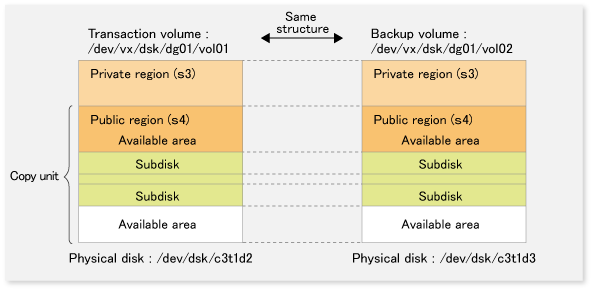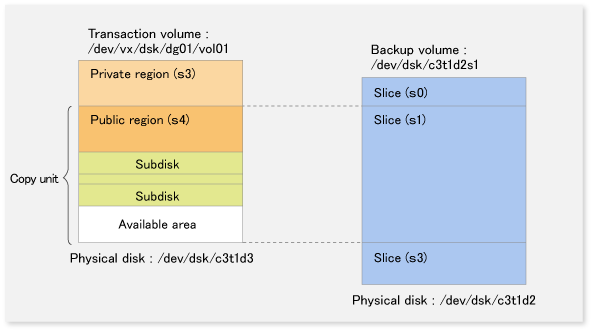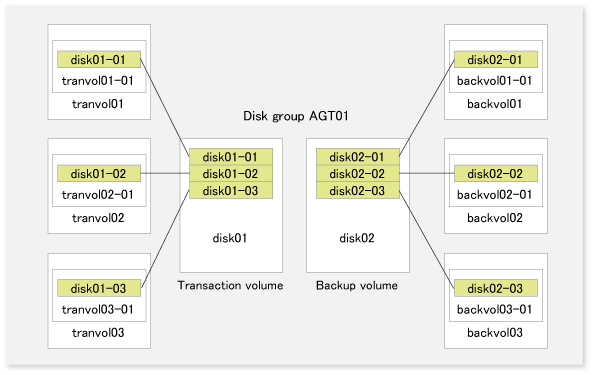When the VxVM volume configuration satisfies the relevant conditions, backup operation can be performed in units of logical volumes.
Note
Before starting this operation, ensure you understand the basic operation of ordinary volumes.
For the supported VxVM volume structures, refer to "1.5 Managing a Device on AdvancedCopy Manager".
The following types of volumes only can be used as backup volumes of VxVM logical volumes:
Logical volume of VxVM
Normal device (slice)
For this backup volume, however, use a VxVM logical volume with the same structure as that of the transaction volume, in anticipation of mounting of the backup volume or its use by other applications.
The same volume structure means the following conditions are satisfied:
The size of the physical disk (LUN) is the same.
The size of the private region is the same.
The size of the public region is the same.
Each sub-disk in the public region has a corresponding start offset and size.
The logical volume and sub-disks have a corresponding association.
Figure 3.13 Example of correspondence between transaction volume and backup volume (1)

Figure 3.14 Example of correspondence between transaction volume and backup volume (2)

Note
If the backup volume is the same size as the public region, a backup volume of a VxVM volume can be made into a normal device (slice). However, it is generally not possible to mount the backup volume and have other applications use it.
Similarly, a backup volume of a normal device (slice) can be made into a VxVM volume. However, it is generally not possible to mount the backup volume and have other applications use it.
If the target VxVM logical volume satisfies the condition of logical volumes:VM disk = N:1 (N>1), use one of the logical volume names included with each VM disk to register a transaction volume or backup volume.
As an example, assume the transaction volume and backup volume in the following volume structure.
Figure 3.15 Volume structure example

VM disk disk01 (transaction volume) has logical volumes named tranvol01, tranvol02, and tranvol03, and VM disk disk02 (backup volume) has logical volumes named backvol01, backvol02, and backvol03.
VM disks disk01 and disk02 have the same slice size. The sub-disk structures of VM disks disk01 and disk02 are the same. (The sub-disk structure can be checked by executing "vxprint -AGts".)
In the above example, use the logical volume names tranvol01 and backvol01 when configuring the device information.
# /opt/FJSVswsts/bin/swstdevinfoset -t /dev/vx/dsk/AGT01/tranvol01 swstdevinfoset completed # /opt/FJSVswsts/bin/swstdevinfoset -b /dev/vx/dsk/AGT01/backvol01 swstdevinfoset completed |
The logical volume specified in the device information configuration command is used to specify the VM disk (slice) for backup processing. This means that tranvol02 or tranvol03 instead of tranvol01 can be set in the above example (and this is also true for backvol01). However, if tranvol01 and backvol01 are already registered, the other volumes (tranvol02, tranvol03, backvol02, and backvo03) cannot be registered.
If the target VxVM logical volume satisfies the condition where logical volumes:VM disk = N:1 (N>1) and unmount/mount processing of the transaction volume with a constructed file system is to be avoided for operational reasons, customize the backup pre-processing script (OpcBackup.pre) so that the transaction volume cannot be unmounted(*).
(*) In such cases, add processing before unmount processing of the backup pre-processing script (OpcBackup.pre) to clear the mount point of the VxVM logical volume, as shown below.
79: exit 0
80: fi
81: post_file="/etc/opt/FJSVswsts"$swstg_node"/data/DEFAULT/"$dev".pre"
82: fstype_file="/etc/opt/FJSVswsts"$swstg_node"/data/DEFAULT/"$dev".fstype"
83: bd_file="/etc/opt/FJSVswsts"$swstg_node"/data/DEFAULT/"$dev".bd"
84:
if [ "$device" = "/dev/vx/dsk/AGT01/tranvol01" ]
then
mount_point=""
fi
85: if [ "$mount_point" != "" ]
86: then
87:
88: # When device cannot be unmounted
89: #
90: # if [ "$device" = "/dev/dsk/c*t*d*s*" ] For the backup operation of a VxVM volume, a device map file must be created because a backup volume in the same volume structure as the transaction volume must be specified.
# Transaction volume Output destination backup volume /dev/vx/dsk/AGT01/tranvol01 /dev/vx/dsk/AGT01/backvol01
For details on the device map file, refer to "3.4.9 Preparing a device map file".
If the target VxVM logical volume satisfies the condition where logical volumes:VM disk = N:1 (N>1), the transaction volume cannot be unmounted/mounted using the pre-processing or post-processing script.
For this type of structure, unmount the file system before executing backup, and mount the file system after backup.
If the target VxVM logical volume satisfies the condition where logical volumes:VM disk = 1:1, the transaction volume is unmounted and mounted in the same way as with normal slices, and the following procedure is not required.
# umount /global/AGT01/tranvol01 <-- unmount tranvol01 # umount /global/AGT01/tranvol02 <-- unmount tranvol02 # umount /global/AGT01/tranvol03 <-- unmount tranvol03 # /opt/FJSVswsts/bin/swstbackup /dev/vx/dsk/AGT01/tranvol01 -Xdevmap /acm/devmap.txt /dev/vx/dsk/AGT01/tranvol01 swstbackup completed # mount -F ufs /dev/vx/dsk/AGT01/tranvol01 /global/AGT01/tranvol01 <-- mount tranvol01 # mount -F ufs /dev/vx/dsk/AGT01/tranvol02 /global/AGT01/tranvol02 <-- mount tranvol02 # mount -F ufs /dev/vx/dsk/AGT01/tranvol03 /global/AGT01/tranvol03 <-- mount tranvol03
To prevent unmount/mount processing of the transaction volume for operational reasons, take action as described in "3.9.1.2.2 Customizing pre-processing and post-processing scripts" and execute backup by using the procedure described below.
# lockfs -w /global/AGT01/tranvol01 <-- lock file system tranvol01 # lockfs -w /global/AGT01/tranvol02 <-- lock file system tranvol02 # lockfs -w /global/AGT01/tranvol03 <-- lock file system tranvol03 # /opt/FJSVswsts/bin/swstbackup /dev/vx/dsk/AGT01/tranvol01 -Xdevmap /acm/devmap.txt /dev/vx/dsk/AGT01/tranvol01 swstbackup completed # lockfs -u /global/AGT01/tranvol01 <-- unlock file system tranvol01 # lockfs -u /global/AGT01/tranvol02 <-- unlock file system tranvol02 # lockfs -u /global/AGT01/tranvol03 <-- unlock file system tranvol03 # fsck -n -F ufs /dev/vx/dsk/AGT01/backvol01 <-- check file system backvol01 # fsck -n -F ufs /dev/vx/dsk/AGT01/backvol02 <-- check file system backvol02 # fsck -n -F ufs /dev/vx/dsk/AGT01/backvol03 <-- check file system backvol03
Note
Even if the command "lockfs -w" is used to flush the file system cache and prevent further update, file contents are not guaranteed whenever the file is in Write Open (excluding the database space of Oracle used to support on-line backup).
If renewal of metadata is currently occurring, consistency of file system data itself cannot be guaranteed because "lockfs" has been specified.
To manage this problem, perform "fsck" after backup to check the consistency of the backup data.
Even if the following message is output in fsck processing, there is no problem with the consistency of the file system. Execute "fsck -y" to restore.
FILE SYSTEM STATE IN SUPERBLOCK IS WRONG; FIX?
If the target VxVM logical volume satisfies the condition where logical volumes:VM disk = N:1 (N>1), the transaction volume cannot be unmounted/mounted using the pre-processing or post-processing script.
For this type of structure, unmount the file system before executing restoration, and mount the file system after restoration.
If the target VxVM logical volume satisfies the condition where logical volumes:VM disk = 1:1, the transaction volume is unmounted and mounted in the same way as in operation with normal slices, and the following procedure is not required.
# umount /global/AGT01/tranvol01 <-- ummount tranvol01 # umount /global/AGT01/tranvol02 <-- ummount tranvol02 # umount /global/AGT01/tranvol03 <-- ummount tranvol03 # /opt/FJSVswsts/bin/swstrestore /dev/vx/dsk/AGT01/tranvol01 /dev/vx/dsk/AGT01/tranvol01 swstrestore completed # mount -F ufs /dev/vx/dsk/AGT01/tranvol01 /global/AGT01/tranvol01 <-- mount tranvol01 # mount -F ufs /dev/vx/dsk/AGT01/tranvol01 /global/AGT01/tranvol02 <-- mount tranvol02 # mount -F ufs /dev/vx/dsk/AGT01/tranvol01 /global/AGT01/tranvol03 <-- mount tranvol03
To change the volume structure during the backup operation, follow the procedure given below.
Specify the -z option for swsthistdel (History information deletion command), to delete all history information.
Use swstbkpoldel (Backup policy deletion command) to delete relevant backup policies.
Delete the registration of the transaction volume by specifying the -o option in swstdevinfoset (Device information setting command). If the backup volume is a VxVM volume, also delete the registration of the backup volume by specifying the -o option in swstdevinfoset (Device information setting command).
Change the transaction volume. If the backup volume is a VxVM volume, also change the volume structure of the backup volume so that the backup volume and transaction volume can be in the same structure.
On the Web Console, execute [Get and reflect information on all devices].
Register the transaction volume and backup volume again by using swstdevinfoset (Device information setting command).
Use swstbkpolset (Backup policy setting command) to set a backup policy.
Resume the backup operation.